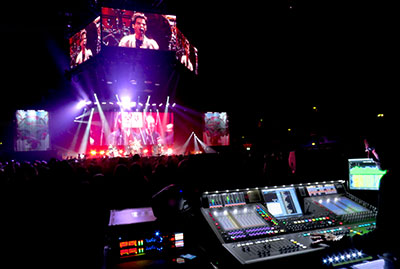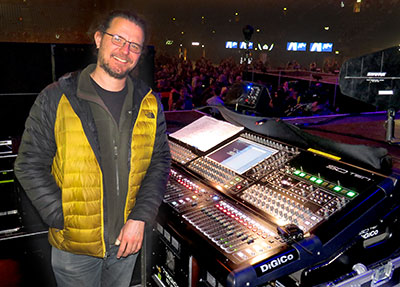Coming almost 20 years after the Welsh rockers Stereophonics won the British Breakthrough Act award at the 1998 BRITs, the band are touring in support of their 10th album, Scream Above the Sounds. On the road, Harm Schopman is looking after monitors for frontman Kelly Jones and the band using a DiGiCo console, supplied by rental company Capital Sound.
 Although in charge of monitors for this tour, Harm has been responsible for various roles on numerous touring productions: ‘On Stereophonics, I originally looked after [FOH engineer] Dave Roden as systems tech, mostly on arena tours,’ he explains. ‘It’s only in the past few years that I have taken on the role of monitor engineer.’
Although in charge of monitors for this tour, Harm has been responsible for various roles on numerous touring productions: ‘On Stereophonics, I originally looked after [FOH engineer] Dave Roden as systems tech, mostly on arena tours,’ he explains. ‘It’s only in the past few years that I have taken on the role of monitor engineer.’
A DiGiCo user since the days of the D5 Live, a console he has used on shows for The Strokes and Katie Melua, the SD10 is now his board of choice for Stereophonics, which he is running at 48kHz with SD Racks shared between FOH and monitors. ‘I love the clarity I can achieve for the IEM mixes using the SD10,’ he says. ‘Everything seems to be easily separated, which means the mixes are very detailed and clean. I’ve used these consoles quite a bit over the years; the interface works perfectly for me and speed of operation is always a priority when working monitors.’
Schopman also uses the Snapshot functionality within the SD10: ‘I have set it up so that most channels are ‘recall safe’,’ he reveals. ‘I am using Snapshots for some mute automation on some of the channels and aux send automation on keyboards, acoustic guitars, and the few channels of FX and supplementary playback that we use, which is strings parts and FX, mostly. I also use some early reflections spatial effect from the SD10 on some of the guitars to give them a little extra width in the mix.’
 One of the key elements of the overall live set-up for Stereophonics is keeping low end minimised on stage, which is achieved through engineering teamwork: ‘Our touring systems/playback/stage tech, Sam Cunningham, plays a large part in achieving this, together with the PA system tech when we have our own system. We also make sure that there are no bass notes that pop out, and Dave [Roden], Sam and I communicate a lot to make the end result as optimal as possible for both the audience and the band.
One of the key elements of the overall live set-up for Stereophonics is keeping low end minimised on stage, which is achieved through engineering teamwork: ‘Our touring systems/playback/stage tech, Sam Cunningham, plays a large part in achieving this, together with the PA system tech when we have our own system. We also make sure that there are no bass notes that pop out, and Dave [Roden], Sam and I communicate a lot to make the end result as optimal as possible for both the audience and the band.
Dave Roden met Stereophonics in 1996 and began touring with them the following year. His relationship with the band is very strong, but the job does not come without its challenges: ‘That’s because the musical programme material is so large and varied,’ he insists. ‘Ten albums and 40 odd singles means a lot of back catalogue to draw upon, which can range from the softest of acoustic songs to out and out rock belters. Having known Kelly [Jones, frontman] and Richard [Jones, bassist] almost half my lifetime does help, though; there are some unspoken understandings which keep things on an even keel. As far as key elements go, it’s always Kelly’s vocal and the guitars first. Everything else second.’
This is the first time Roden has been out with a DiGiCo board for six years, so the decision was an important one: ‘I toured very happily with a D5 for five or six years but was diverted down another road mainly for logistical reasons,’ he recalls. ‘Going back to DiGiCo was a really considered decision, not just for logistics – a big part of this being that Mark Saunders, who is one of the best guys in the business, had joined from Sennheiser. But for the cost versus other brands and the benefits it would bring for the rest of the audio department: reducing stage footprint by rack-sharing, futureproofing and expansion capabilities of the Optocore network, and, of course, the flexibility this would give the band when thinking of arena show B-stages, and so on. Then there is my overall familiarity with the DiGiCo surface and software, which has reduced transfer time to a minimum – that has been extremely important.’
Roden favours DiGiCo Snapshot functionality, too: ‘I use Snapshots on inputs, for muting unused channels, level changes on faders, and FX and Aux sends, as well as some very selective EQ and dynamics changes, and reverb and delay FX presets,’ he says. ‘I also have macros programmed to do other semi-automated tasks, such as switching inputs.’
After completing the UK leg of the tour with a performance at Rise Festival in August, Stereophonics crossed to North America to play a series of shows in Vancouver, Toronto, Chicago, and New York City. Their DiGiCos went with them.














